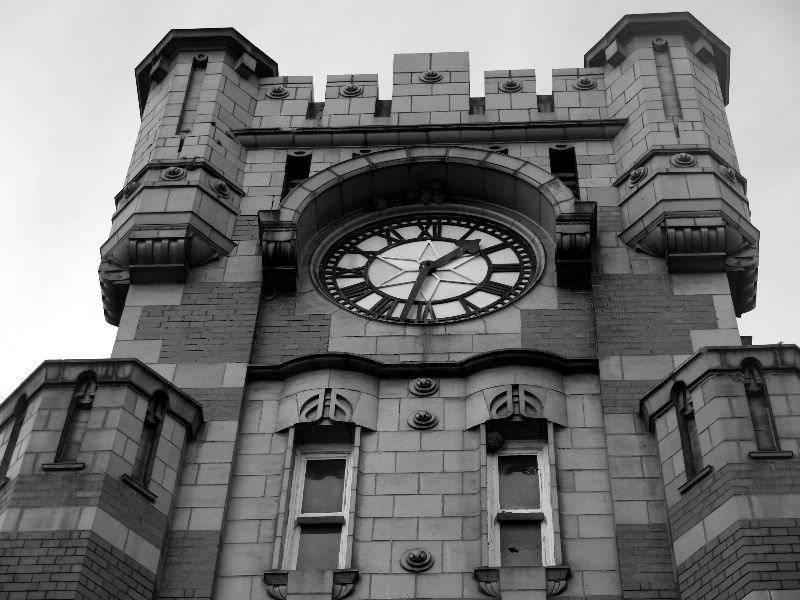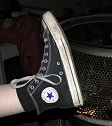 |
 |
|
UER Store
|
|
sweet UER decals:

|
|
 |
 celtes
  
Location: Wales, UK
Gender: Female
 | |  | Shotton Steel Works, North Wales
< on 11/3/2012 5:01 PM >
|  | | | In 1896 the "Hawarden Bridge Steelworks" opened on a 6-acre site, and within a year 250 were employed. In 1898 the firm became a Private Limited Company. In 1908, on completion of new offices the company transferred its headquarters to Shotton. This elegant symmetrical building of polished red brick and terra-cotta is said to resemble the Midland Hotel in Manchester. It was designed by Henry Summers’ friend, James France, and is of Edwardian style. It consists of 5 storeys, and its imposing, castellated central clock tower still overlooks Shotton today, contrasting with the high-tech factories that surround it.
By the year 1909 the company was the largest manufacturer of galvanized steel in the country, and probably the largest manufacturer of steel nail strips and sheets. The site now occupied 60 acres and 10,000 acres of marshland had been purchased. Looking across the Dee from Shotton, the factory had the appearance of a town of small factories, and there were 26 tall chimney stacks. The workforce had now reached 3000 and the weekly wage bill was £6000. The capacity of the factory was 160,000 tons of steel per annum.
But all was not well at the works. Trouble started in November 1909 over what was known as the Contract System. On each mill, one man employed ten others on a piecework system and the Firm paid the contractor for each ton of finished steel sheets. Differences in pay and favoritism led many of the undermen to join the Steel Smelters Union in order to get the Contract System abolished. They then threatened the Firm with strike action if it did not meet their demands. To keep the peace, Henry drew up an agreement with the Union, and thought that would be the end of the matter, but the Iron and Steel Contractors were angered. They wanted to keep the System, refused to recognize the Smelters Union, and came out on strike.Henry Summers attempted to keep the works running by drafting in workers from other areas. At the main gates men were posted on picket duty, and in an attempt to prevent any trouble on the picket lines, and to guard the Works, many policemen from a wide area were drafted in. But, as an eyewitness account explains, trouble erupted at Shotton station on the 17th and 16th March 1910.
On the Saturday morning following the riot, a special conference took place at the Head Office of the works. Representatives of all the unions involved were present and the situation was fully discussed. It was decided that a truce should take place immediately, that all the pickets on both sides should be removed, that no further attacks or demonstrations of violence should take place between members of the contending unions; that the workmen at that time employed at the works be allowed to travel to and from the works; and that a peaceable situation be restored pending the decision of the Parliamentary Committee of Trades Union Congress in Chester was made known. It was arranged that all the workers leave their weapons behind at the works, and should depart to their homes in the usual manner, as if nothing unusual had occurred. The workmen agreed to the requests and left the works at their usual finishing time for the weekend. There were no reports of any further violence from either side. The railway police left the area later in the day, but about forty men of the Cheshire Constabulary arrived by train to reinforce the Flintshire Constabulary men, as a precaution.
Although there was no repeat of the trouble, the dispute continued through the year, and the importation of workers to keep the works running did not prevent heavy losses. Between February and November the company lost £60,000, mainly due to the increased percentage of defective sheets produced by the unskilled labour.On the afternoon of Friday 2nd December 1910, Henry Summers called a mass meeting of employees at the works, and nearly three thousand men assembled in the Galvanizing and Packing department.Henry made it clear to the men that during his speech he wanted no applause or expression of opinions; he only wanted them to listen quietly to what he had to say. He told them that, as they left the works, each man would be given a full copy of the speech, and this would give them an opportunity to look over it and discuss it amongst themselves. The meeting was not the place for expressing the differing opinions of the men, and therefore he did not want the slightest expression of feeling there.In it Henry gives a full and detailed account of the dispute and a graphic description of the frustration he was experiencing in being caught in the middle of a Trade Union war.Common sense prevailed, following the speech and the vast majority of men had returned to work by 29th December.
By 1915 output had increased to 240,000 tons, and a second steel plant was under construction. In 1919 the Wolverhampton Corrugated Iron Company at Ellesmere Port was taken over by John Summers. They also bought the Castle Fire Brick company in Buckley. The next year they took over the Shelton Iron, Steel and Coal Company of Stoke-on-Trent. This company was Shotton's supplier of pig iron, a very scarce item at the time and this acquisition meant that the company had become very largely self-contained and self-sufficient.
This expansion was not continuous however. Traditional oversees markets for Shotton Steel declined during the Great Depression, between the wars. In 1929 the rolling mills at the Stalybridge plant were closed down, and two years later, this slump affected Shotton. By 1930 the workforce totalled 6000, but on 24th April 1931, a day that came to be known locally as "Black Friday," without any notice at all, 4,000 employees were handed an envelope containing a letter which read:
"The last few weeks have been the most unpleasant and anxious that the Directors have ever had to face. They realize that in the actions they are now taking they have to tell many of the firm's most loyal servants that there is no more work for them. They have studied every individual case and, whilst it is hard to dispense with those who have rendered faithful service to the company for many years, they feel that, in the interests of the firm, no other course is open to them. You will, however, be paid two weeks salary in lieu of notice."
Recovery began in 1937 when a continuous hot & cold strip mill was installed following negotiations with the Mesta Machine Company of Pittsburgh, U.S.A. The site of this strip mill covered 27 acres and was raised 17 feet above the existing land in order to provide a suitable foundation. This required the pumping of 750,000 tons of sand from the estuary.
Throughout the war the works ran at full capacity. One of the Hawarden Bridge Works most famous products was made in this period. It was a curved, corrugated steel sheet known as the Anderson Air Raid Shelter, which saved many lives during the Blitz. Fifty thousand were produced every week, but a shortage of zinc, used to galvanize the sheets, meant that the Morrison Shelters, designed for indoor use, superseded the Anderson Shelters.
At its peak the works employed more than 13,000. In 1967 the steel industry was nationalised again and the Shotton Works became part of the Summers Division of the Scottish and Northwest Group of the British Steel Corporation.
In 1969 the Globe Ironworks closed down in Stalybridge, and following many years of speculation, the party finally ended in Shotton three years later. In 1972 B.S.C. announced a 10 year plan that would culminate in the loss of about 7,000 steel-making jobs. All 13 unions fought the closure but were unsuccessful. In February 1980, the most disastrous day in Shotton's history, 6,000 jobs were lost. The last cast of steel produced passed by virtually unnoticed, and without ceremony, for the works was on strike at the time.
The end of steel-making at the site was devastating to Shotton and the Deeside area, which relied heavily on the works as the main employer in the area. Shotton now takes its unenviable place in history as the community that suffered the greatest mass loss of job opportunities in living memory. The closure of the cold strip mill and an electro-galvanising line in 2001 saw the workforce reduced further. Shotton Steelworks now employs a mere 700 in what has become a state-of-the-art steel coating plant.
1.

2.

3.

4.

5.

6.

7.

|
|
Tenebrae
  
Location: The Wild West

Life's short; eat dessert first.
 | |  | Re: Shotton Steel Works, North Wales
<Reply # 1 on 11/4/2012 12:52 PM >
|  | | | Any chance you'll get inside?
|
|
celtes
  
Location: Wales, UK
Gender: Female
 | |  | Re: Shotton Steel Works, North Wales
<Reply # 3 on 11/4/2012 10:03 PM >
|  | | | Posted by Tenebrae
Any chance you'll get inside?
|
I had a good look but it was pretty well boarded up and fenced off. I wouldn't break in... I only enter places that have obvious entrances. I'd love to see inside though.
|
|
Guerrillaexplorer066
  
Location: London, UK

 | |  | |  | Re: Shotton Steel Works, North Wales
<Reply # 4 on 11/5/2012 8:24 AM >
|  | | | Posted by celtes
I had a good look but it was pretty well boarded up and fenced off. I wouldn't break in... I only enter places that have obvious entrances. I'd love to see inside though.
|
clearly you're not trying hard enough, I can see at least one obvious entry point in your pics that doesn't involve damage, also there's a spiral staircase to the roof over the palisade. Probably opportunities there.
You should probably also credit the source of your historical write-up, where they put the effort in to research the place. www.angelfire.com/...ton/history11.html
Most of your recent flurry of reports appear to involve walking around the outside of empty buildings, rather than any actual exploring. Maybe try harder next time 
Website FB |
|
celtes
  
Location: Wales, UK
Gender: Female
 | |  | Re: Shotton Steel Works, North Wales
<Reply # 5 on 11/5/2012 11:33 PM >
|  | | | Posted by Guerrillaexplorer066
clearly you're not trying hard enough, I can see at least one obvious entry point in your pics that doesn't involve damage, also there's a spiral staircase to the roof over the palisade. Probably opportunities there.
You should probably also credit the source of your historical write-up, where they put the effort in to research the place. www.angelfire.com/...ton/history11.html
Most of your recent flurry of reports appear to involve walking around the outside of empty buildings, rather than any actual exploring. Maybe try harder next time 
|
You can't get to the spiral staircase... you'd have to go up another broken staircase leading to the first floor (steps were rusted through from about 6 from the top) and then over/through the palisade. I did have a good look.
I assume by "flurry" you mean the three posts that I have just put up, and maybe a couple from my Scotland trip. Well, there were people at the ship and I think an attempt to get in would have been pretty damn stupid under the noses of the owner, photographer and three graffiti artists. The lighthouse has one entrance with a padlocked door that would take some serious tools to break. Brough Lodge was undergoing renovation and was full of builders.
I do this for fun. I love seeing the buildings... I love taking photos. I love finding stories online and elsewhere about the places. Maybe I'm not as hardcore as some people, but I can live with that.
|
|
Anaklusmos
 
Location: Where I want to be, not where I should be.
Gender: Male

I'm a man of many hats.
 | |  | Re: Shotton Steel Works, North Wales
<Reply # 6 on 11/9/2012 6:33 PM >
|  | | | AMAZING looking place! Someone's gotta get in there and show us its true awesomeness!
Fucking Spiders..... |
|
Kurt
     
Location: Taxachusetts
Gender: Male

NEVER SAY DEVER!
 | |  | |  | Re: Shotton Steel Works, North Wales
<Reply # 7 on 11/15/2012 5:46 AM >
|  | | | wish you had some interiors... but these are some nice exteriors!
"What is your favorite thing about Belchertown?"
"...the history, man" |
|
|
|
All content and images copyright © 2002-2024 UER.CA and respective creators. Graphical Design by Crossfire.
To contact webmaster, or click to email with problems or other questions about this site:
UER CONTACT
View Terms of Service |
View Privacy Policy |
Server colocation provided by Beanfield
This page was generated for you in 187 milliseconds. Since June 23, 2002, a total of 741250068 pages have been generated.
|
|
















